What is an SQDCL Board?
An SQDCL board is a visual management tool used to monitor and improve key performance indicators (KPIs) in areas such as Safety, Quality, Delivery, Cost, and Lean within an organisation. It helps teams track progress, identify issues, and drive continuous improvement.
Safety: Tracks accidents, near-misses, and safety-related incidents.
Quality: Monitors defect rates, rejects, and other quality-related metrics.
Delivery: Tracks on-time delivery, lead times, and other delivery-related performance.
Cost: Monitors financial performance, including production costs, material costs, and other financial metrics.
Lean: Focuses on waste reduction, process optimisation, and other lean principles.

Safety
The Balanced Scorecard monitors workplace accidents and documents significant near-misses that occur on-site. It evaluates health and safety performance, offering a comprehensive view of safety measures and highlighting areas that require improvement.
- Accidents
- Near Misses
- Safety Incidents
- Safety Talks
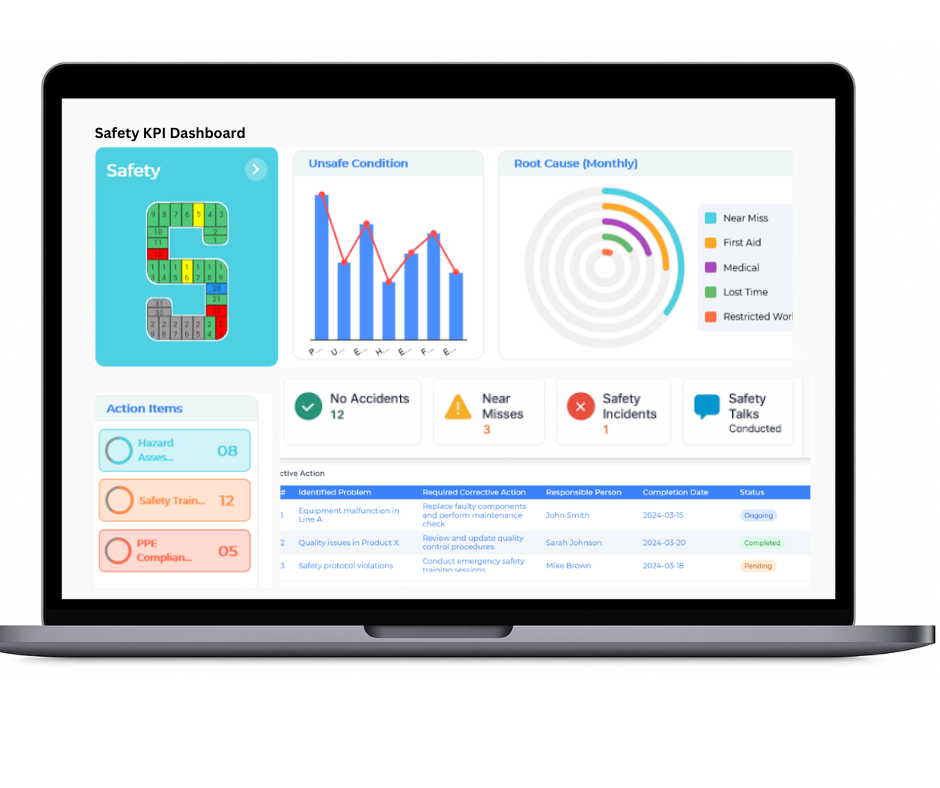
Quality
Quality metrics in the Balanced Scorecard enable organisations to assess defect levels in both incoming and in-house products, as evaluated by customers. By leveraging these metrics, organisations can efficiently manage and monitor their quality control processes.
- Accidents
- Test Failures
- Rework
- Non-Conformance Items
- Defects
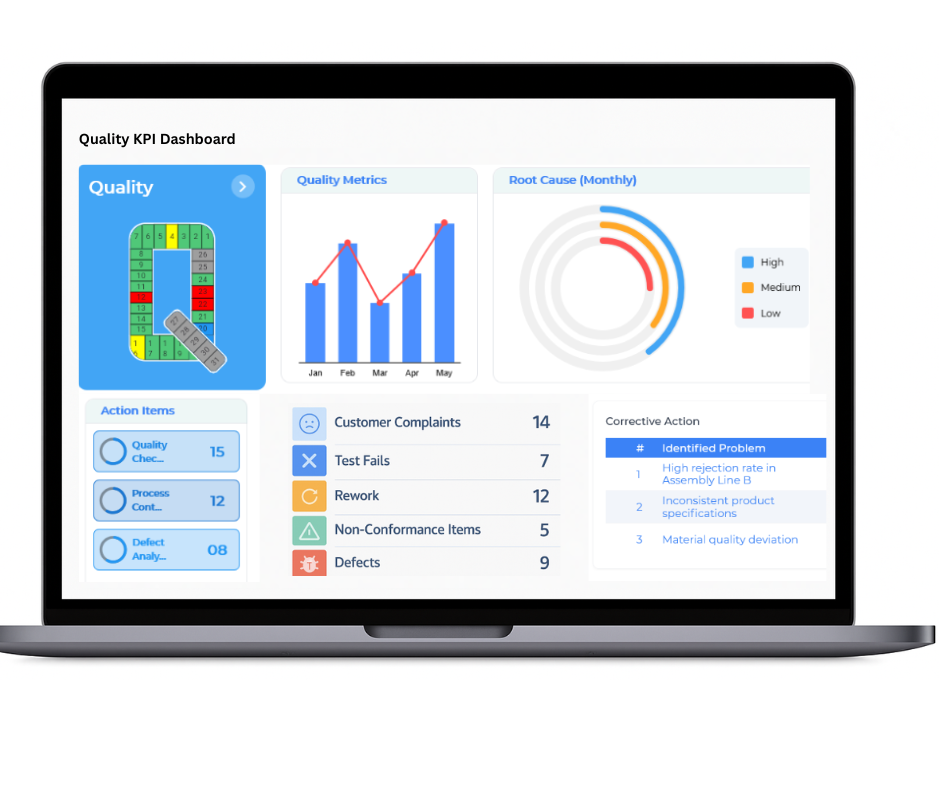
Delivery
The Balanced Scorecard tracks all delivery processes, ensuring On Time In Full (OTIF) performance from suppliers to customers. It evaluates warehouse operations and inventory movements, providing the management team with crucial data for making informed decisions.
- Number of Late Deliveries
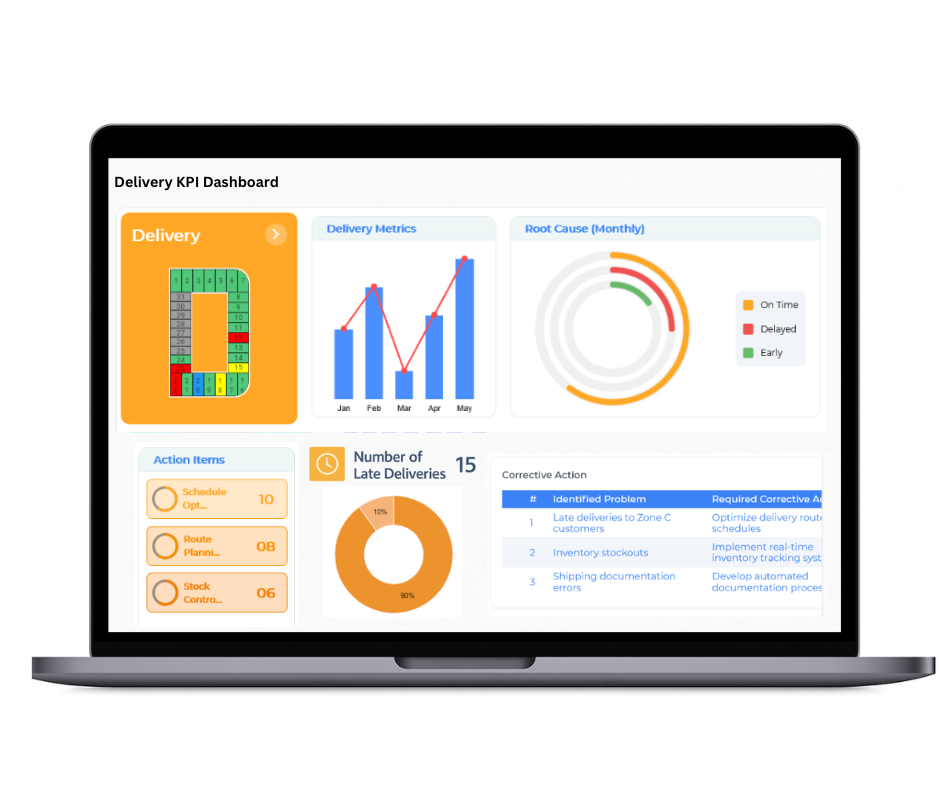
Cost
Financial goals and objectives are critical and sensitive metrics for any organisation. The Balanced Scorecard effectively manages financial objectives by analysing the organisation's financial data, providing comprehensive insights for better decision-making.
- Number of Customer Complaints
- Product Returns
- Feedback Trends
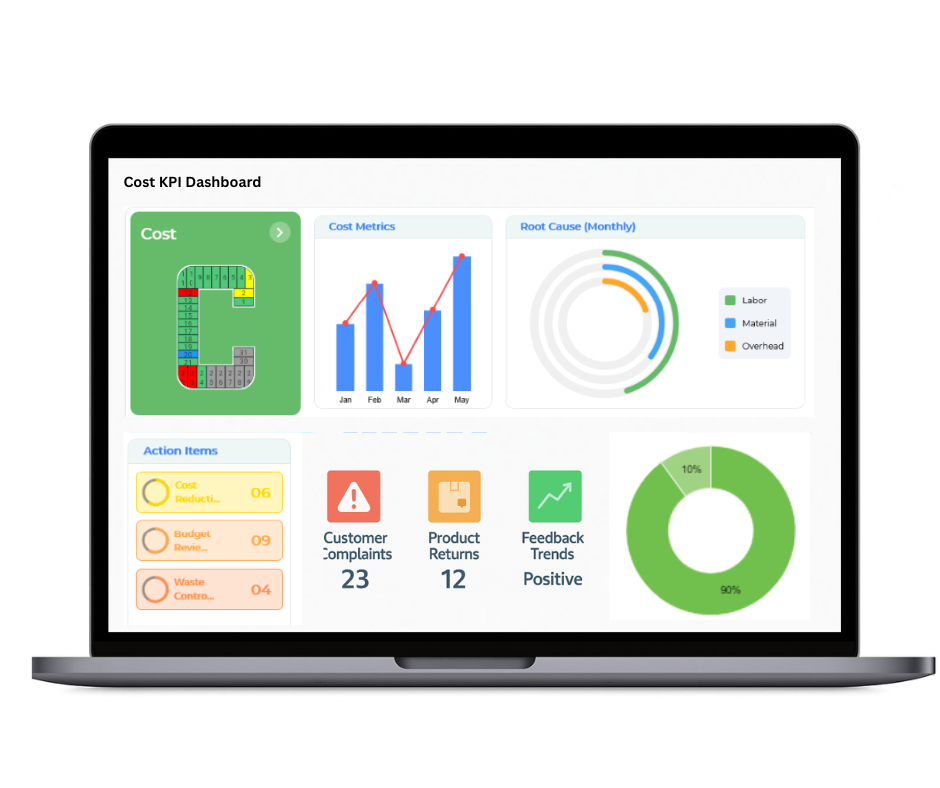
Lean
Lean focuses on eliminating waste, improving efficiency, and promoting continuous improvement. It enhances productivity through streamlined processes, employee involvement, and standardised practices for consistent and effective operations.
- Waste Reduction
- Continuous Improvement
- Flow Efficiency
- Employee Involvement
- Standardised Work
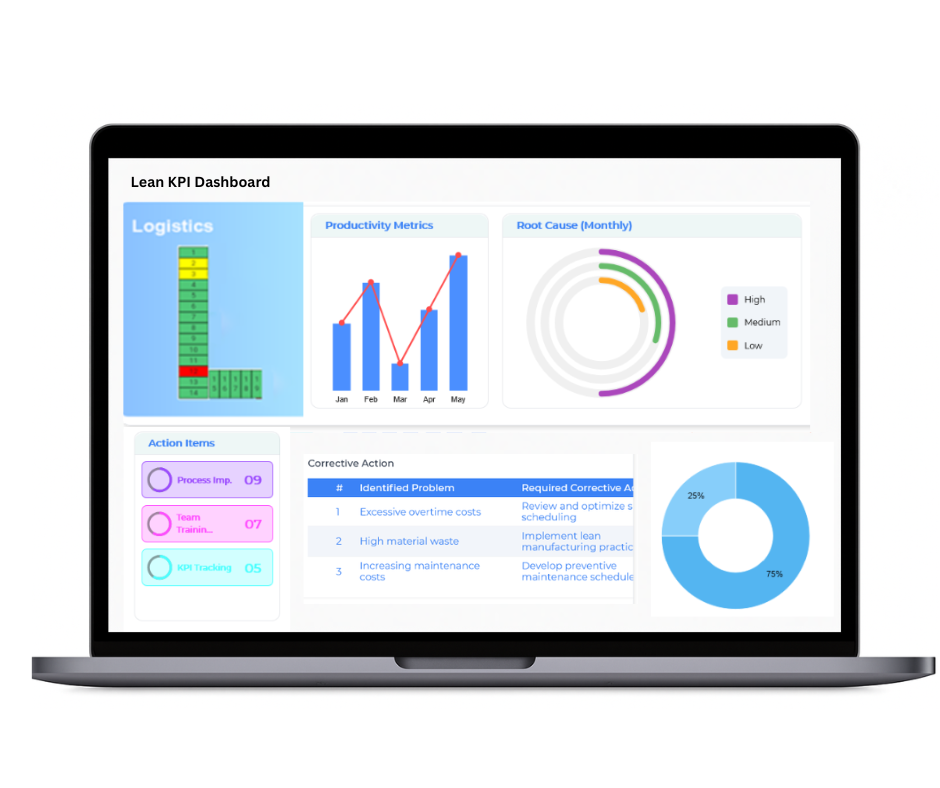
SQDCL Board for Shift Management
- Real-Time Tracking: Continuously monitors Safety, Quality, Delivery, Cost, and People metrics for each shift.
- Enhanced Safety Monitoring: Records accidents, near-misses, and safety checks to maintain a secure workplace.
- Quality Control Per Shift: Tracks defects, rework, and compliance with quality standards.
- Delivery Performance: Measures production output, OTIF (On Time In Full), and identifies delays.
- Cost Management: Monitors resource usage, waste, and operational expenses per shift.
- People & Performance: Assesses attendance, engagement, training, and teamwork.
- Rapid Issue Resolution: Allows teams to promptly flag and address problems.
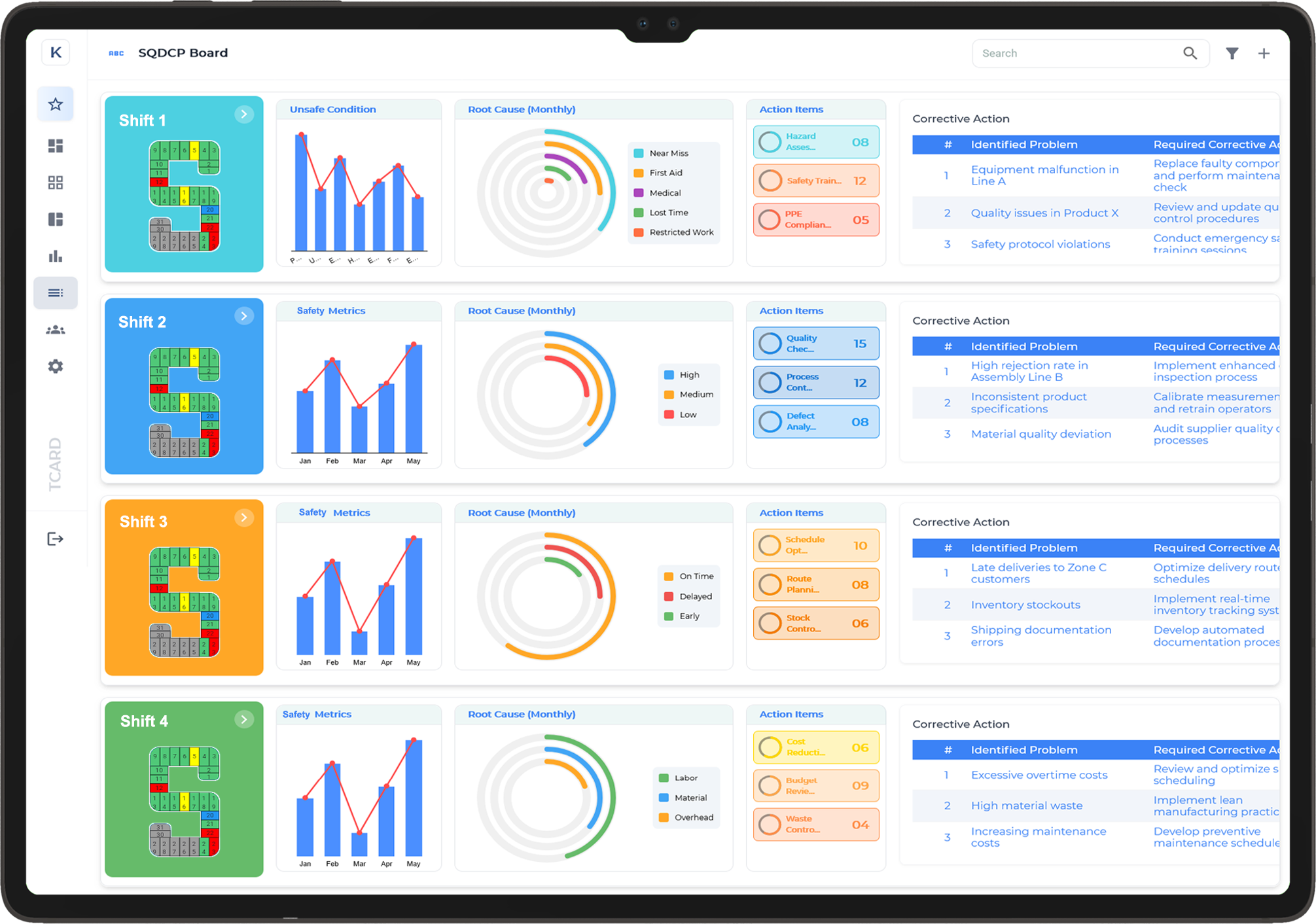
What is an SQDCL Board and Why Is It a Game-Changer for Operational Excellence?
An SQDCL board is a visual management tool used to track and improve five key elements of operational performance: Safety, Quality, Delivery, Cost, and Labour. The addition of 'Labour' makes this board a more comprehensive tool compared to traditional SQDCP boards. This makes it an invaluable resource for organisations aiming to drive operational excellence, enhance productivity, and streamline processes.
Safety
Safety is always a top priority in any operational setting. The SQDCL board allows teams to monitor safety metrics closely, ensuring that any safety concerns are addressed promptly. This proactive approach helps minimise accidents and foster a culture of safety within the workplace.
Quality
Quality control is a crucial element of operational success. The SQDCL board provides a clear overview of quality performance, enabling teams to quickly identify defects or quality issues and implement corrective measures. This leads to improved product or service quality, greater customer satisfaction, and reduced waste.
Delivery
On-time delivery is essential for customer satisfaction and operational efficiency. The SQDCL board helps teams track delivery performance, ensuring deadlines are met consistently. By identifying delays and bottlenecks early, teams can take corrective actions and optimise their delivery processes.
Cost
Cost management is critical to maintaining profitability. The SQDCL board allows organisations to monitor costs in real-time, helping to identify areas of inefficiency, overspending, or waste. This enables teams to take targeted actions to reduce costs and improve profitability.
Labour
Labour performance focuses on workforce engagement, productivity, and skills. The addition of the 'Labour' element on the SQDCL board ensures that teams can track performance and identify training needs, improving employee productivity and morale.
In summary, the SQDCL board is a game-changer for operational excellence. By providing a clear, visual overview of these five key performance areas, organisations can make data-driven decisions, optimise processes, and foster a culture of continuous improvement.
The Power of Visual Management: How SQDCL Boards Keep Teams Aligned
Visual management is a powerful tool for enhancing team alignment and boosting operational performance. One of the most effective tools for visual management is the SQDCL board, which tracks five key performance elements: Safety, Quality, Delivery, Cost, and Labour. These boards make it easier for teams to stay aligned, improve communication, and drive continuous improvement across all areas of operations.
Safety
Safety is always a priority in any operation, and the SQDCL board helps teams stay focused on safety metrics. By displaying safety data visually, employees can quickly identify any issues or risks, enabling prompt corrective action. This reduces accidents, protects employees, and helps maintain a safe working environment.
Quality
Ensuring consistent quality is vital for business success. The SQDCL board tracks quality performance in real-time, allowing teams to spot defects or issues early on. By visualising quality data, employees can respond to problems quickly, leading to improved product quality, reduced waste, and greater customer satisfaction.
Delivery
On-time delivery is critical to meeting customer expectations. The SQDCL board keeps delivery performance at the forefront, helping teams track progress and identify delays. This visibility enables quick action to prevent missed deadlines, ensuring customer satisfaction and operational efficiency.
Cost
Controlling costs is essential for profitability. By displaying cost data visually on the SQDCL board, teams can track spending in real-time, spot inefficiencies, and make informed decisions to reduce waste and improve cost management.
Labour
Labour performance is equally important. The SQDCL board provides insight into workforce productivity, helping teams identify areas for training or development. This ensures optimal labour utilisation, improving overall efficiency and employee engagement.
Understanding Each Pillar: Safety, Quality, Delivery, Cost, and Leadership
In the pursuit of operational excellence, businesses focus on five essential pillars: Safety, Quality, Delivery, Cost, and Leadership. Each of these pillars plays a crucial role in driving continuous improvement and ensuring the overall success of an organisation. Here’s a closer look at each one:
Safety
Safety is always the top priority in any workplace. Ensuring a safe environment not only protects employees but also reduces downtime and boosts morale. By tracking safety metrics, organisations can proactively address potential hazards, ensuring that staff work in a secure and healthy environment. A strong safety culture promotes well-being and reduces costly accidents.
Quality
Maintaining high-quality standards is essential for delivering products and services that meet or exceed customer expectations. Consistent quality enhances brand reputation, customer loyalty, and reduces waste. Quality management systems enable teams to monitor, control, and improve the production process, ensuring the final output meets strict standards of excellence.
Delivery
On-time delivery is key to meeting customer expectations and maintaining competitiveness. Timely deliveries show customers that they can rely on your business to meet deadlines. Effective management of delivery schedules ensures smooth operations, reduces delays, and strengthens customer trust and satisfaction.
Cost
Controlling costs is fundamental for profitability. By reducing waste and optimising resources, businesses can improve their bottom line. A focus on cost management helps identify inefficiencies and areas for improvement, contributing to financial sustainability and enabling the organisation to stay competitive in a challenging market.
Leadership
Leadership drives organisational culture and continuous improvement. Strong leadership sets clear goals, inspires teams, and fosters a culture of accountability and innovation. Effective leaders guide teams through challenges, encourage collaboration, and ensure that each pillar—safety, quality, delivery, and cost—remains a priority in everyday operations.
In summary, these five pillars are interconnected, each supporting the other to create a balanced and effective approach to operational excellence.
How the ‘L’ in SQDCL Drives Stronger Leadership and Accountability
The ‘L’ in SQDCL stands for Leadership, and it plays a crucial role in driving continuous improvement within organisations. Leadership in this context is not just about managing day-to-day activities; it’s about fostering a culture of accountability, collaboration, and strategic decision-making that permeates all levels of the organisation.
Encouraging a Culture of Accountability
Strong leadership ensures that accountability is embedded within the team’s DNA. By setting clear goals, expectations, and performance indicators, leaders can motivate employees to take ownership of their tasks and outcomes. When everyone is accountable for their actions, teams perform more efficiently, and any issues are addressed promptly, leading to a more cohesive and productive work environment.
Providing Direction and Vision
Effective leaders provide a clear direction for the team, ensuring that all efforts align with the organisation’s objectives. They inspire teams with a shared vision, ensuring that everyone understands the larger purpose behind their tasks. This clarity helps eliminate confusion and ensures that everyone is working towards the same goal, enhancing overall productivity and reducing mistakes or miscommunication.
Empowering Team Members
Leadership in SQDCL isn’t just top-down; it’s about empowering team members to take initiative and make decisions within their scope. Leaders encourage employees to come up with solutions, fostering a sense of ownership and involvement in the decision-making process. This empowerment boosts morale, increases job satisfaction, and drives continuous improvement by tapping into the collective intelligence of the team.
In summary, the ‘L’ in SQDCL is pivotal in driving strong leadership, accountability, and continuous improvement. By providing direction, fostering a sense of ownership, and empowering employees, leaders can ensure their teams perform at their best, ultimately contributing to the organisation’s success.
Using SQDCL Boards to Identify and Solve Daily Operational Challenges
SQDCL boards are powerful tools for tracking and improving operational performance, especially when it comes to identifying and solving daily challenges. The SQDCL framework, which focuses on Safety, Quality, Delivery, Cost, and Leadership, helps organisations monitor key performance indicators (KPIs) in real time, allowing for quick identification of issues and efficient problem-solving.
Tracking Daily Challenges Across Five Key Pillars
Each pillar of SQDCL represents a critical area that can influence overall performance. For example, daily safety issues, quality defects, delivery delays, and cost overruns can be easily tracked using the visual elements of an SQDCL board. By keeping a close eye on these key areas, teams can quickly spot trends and pinpoint where problems are emerging, allowing for faster responses before issues escalate.
Encouraging Timely Interventions
One of the key benefits of using SQDCL boards is that they promote quick interventions. When a problem is identified in any of the pillars—be it a safety incident, a quality issue, or a delivery delay—the team can address it promptly. Leaders can use the board to assign responsibility for solving the issue, ensuring that the right people are empowered to take action and implement solutions without delay.
Fostering Continuous Improvement
By regularly reviewing the SQDCL board, teams can identify recurring problems and trends, which are the root causes of operational challenges. This continuous monitoring fosters a culture of improvement where the team consistently evaluates processes and looks for ways to enhance efficiency and effectiveness, ensuring that problems are addressed before they become larger issues.

Making Continuous Improvement a Daily Habit with SQDCL Tracking
In today’s fast-paced business environment, continuous improvement is key to staying competitive. Using SQDCL tracking boards, which focus on Safety, Quality, Delivery, Cost, and Leadership, organisations can make this vital practice a part of their daily operations. The visual nature of SQDCL boards makes it easier for teams to identify issues, track progress, and make necessary adjustments in real time, helping foster a culture of ongoing improvement.
Integrating Continuous Improvement into Daily Operations
The beauty of SQDCL tracking lies in its simplicity and effectiveness. By breaking down key operational metrics into daily, manageable elements, teams can see what’s working and what isn’t. For example, daily tracking of safety incidents or quality control failures helps organisations spot potential risks early. This empowers teams to make immediate corrective actions and prevent bigger problems from emerging.
Tracking and Solving Problems Every Day
SQDCL boards also encourage the habit of daily review. Leaders and team members regularly gather to discuss the performance of the previous day, identify challenges, and plan solutions. This continuous feedback loop ensures that issues are tackled before they grow, making it easier for organisations to maintain high standards in all operational areas.
Fostering a Culture of Accountability and Leadership
One of the key benefits of SQDCL tracking is that it supports leadership and accountability. Team members are encouraged to take responsibility for improvements in their specific areas, which fosters a sense of ownership and commitment to quality. Over time, this daily habit of reflection and action drives a more engaged, proactive team.
Safety First: Using SQDCL to Cultivate a Zero-Incident Culture
Creating a zero-incident culture is a top priority for organisations committed to safety. Using SQDCL boards, which track Safety, Quality, Delivery, Cost, and Leadership, can significantly enhance safety management by making safety issues visible and manageable. This approach helps identify potential hazards, reduce risks, and encourage proactive safety practices across teams.
Tracking Safety for a Safer Workplace
Safety is the first pillar in the SQDCL framework, and it plays a critical role in fostering a zero-incident culture. By consistently tracking safety metrics such as near misses, injuries, and unsafe behaviours, organisations can quickly identify patterns or areas that need improvement. This continuous monitoring ensures that safety remains a top priority every day.
Empowering Employees to Take Ownership of Safety
Using SQDCL boards encourages employee involvement in safety initiatives. By visualising safety data on a daily basis, team members can take ownership of safety improvements in their areas. They are more likely to spot potential risks, suggest improvements, and feel accountable for maintaining a safe working environment.
Creating a Culture of Proactive Safety
The key to a zero-incident culture is a proactive approach to safety. SQDCL boards help foster this by ensuring that safety issues are discussed regularly and resolved promptly. Daily updates on safety performance allow teams to make small adjustments before larger problems arise, reducing the likelihood of accidents and injuries.
Boosting Quality Standards Through Real-Time Monitoring on SQDCL Boards
Maintaining high-quality standards is essential for any organisation aiming for long-term success. SQDCL boards are an invaluable tool for real-time monitoring of quality metrics, helping teams to maintain and continually improve their product and service quality. The "Quality" pillar of the SQDCL framework plays a central role in tracking and addressing quality issues promptly, ensuring that any defects or deviations from standards are caught early.
Real-Time Visibility for Immediate Action
One of the primary advantages of using SQDCL boards is the real-time visibility they offer. With quality performance data displayed clearly, teams can immediately spot any issues affecting product or service quality. This allows for swift action to be taken, preventing quality problems from escalating and ensuring that corrective measures are implemented without delay.
Fostering a Culture of Continuous Improvement
Regular tracking of quality metrics through SQDCL boards not only highlights current quality levels but also encourages a culture of continuous improvement. Teams are empowered to identify root causes of issues, explore solutions, and implement improvements. By focusing on quality every day, organisations can gradually raise their quality standards and avoid the recurrence of issues.
Enhancing Accountability Across Teams
With SQDCL boards, accountability for quality is shared across the entire team. Each member can see how their actions impact quality, fostering a sense of responsibility and ownership. This collaborative approach helps teams stay committed to upholding the highest quality standards, leading to better results and customer satisfaction.
In summary, using SQDCL boards to monitor quality in real-time enables faster issue resolution, promotes a culture of continuous improvement, and enhances accountability across teams, all of which contribute to stronger quality standards and better overall performance.
Improving On-Time Delivery with Better Visibility and Team Focus
On-time delivery is a critical factor in customer satisfaction and business success. SQDCL boards provide enhanced visibility and focus, making it easier to manage and improve delivery timelines. By tracking the "Delivery" pillar in real-time, teams can identify potential delays and take proactive steps to ensure timely product or service delivery.
Real-Time Tracking for Improved Efficiency
With SQDCL boards, delivery performance is clearly visible to everyone involved. Teams can quickly see whether tasks are on track or falling behind, allowing for swift corrective actions. This real-time monitoring helps to eliminate bottlenecks, minimise delays, and ensure that deadlines are met. The ability to track progress against set targets also enables teams to prioritise critical tasks and focus on what needs to be done to stay on schedule.
Encouraging Team Collaboration and Accountability
The collaborative nature of SQDCL boards ensures that every team member is aligned with the overall delivery goals. By providing a clear visual representation of progress, it encourages accountability, with everyone understanding their role in meeting deadlines. The board fosters a sense of ownership, driving each individual to contribute to the team’s success and stay focused on delivering on time.
Identifying and Addressing Potential Delays
One of the most significant advantages of using SQDCL boards for delivery tracking is the ability to identify potential delays early. By constantly monitoring delivery metrics, teams can spot any issues that may hinder timely completion. Early identification allows for immediate action to resolve problems, preventing small setbacks from becoming major disruptions.
Reducing Waste and Optimising Costs with the Cost Column of SQDCL
Effective cost management is crucial for any organisation aiming to maintain profitability and operational efficiency. The "Cost" column on an SQDCL board plays a vital role in helping businesses track and optimise their expenditures, thereby reducing waste and improving overall financial performance.
Tracking Costs in Real-Time
One of the primary benefits of the "Cost" column on SQDCL boards is the ability to track expenses in real-time. By clearly displaying current costs alongside other operational metrics like safety, quality, and delivery, teams can quickly identify areas where spending is exceeding expectations. This immediate visibility allows businesses to take swift action, ensuring that costs remain under control and any overages are addressed promptly.
Identifying Waste and Inefficiencies
Waste reduction is a key focus in modern operational management, and the "Cost" column helps highlight inefficiencies that can lead to unnecessary expenditures. By continuously monitoring costs, businesses can identify areas of waste—whether it be excess inventory, unnecessary labour, or inefficient processes. With this data, organisations can take corrective actions, streamline workflows, and eliminate wasteful practices, ultimately reducing overall costs.
Promoting Cost Awareness Across Teams
The visual nature of SQDCL boards encourages team members at all levels to be more conscious of costs. As cost-related information is readily available and shared, it fosters a culture of cost awareness within the organisation. Employees become more mindful of the financial implications of their actions, which can drive cost-saving initiatives and more efficient resource use.
Empowering Frontline Leaders Through the Leadership Pillar
The "Leadership" pillar of SQDCL boards plays a critical role in empowering frontline leaders to drive operational excellence. By focusing on leadership at the operational level, organisations can ensure that their teams are aligned, motivated, and performing to the best of their abilities. This pillar provides frontline leaders with the tools they need to make informed decisions, support their teams, and foster a culture of continuous improvement.
Developing Strong Leadership Skills
The Leadership pillar encourages the development of key leadership skills within frontline managers. By providing real-time data and visual tracking, SQDCL boards help leaders monitor team performance, identify challenges, and address issues before they escalate. This proactive approach not only enhances decision-making but also strengthens the leadership abilities of managers, allowing them to confidently guide their teams through daily operations.
Fostering Accountability and Ownership
One of the key benefits of the Leadership pillar is the emphasis on accountability. With clear visibility of operational metrics such as safety, quality, delivery, and cost, leaders are better equipped to take ownership of their team’s performance. This transparency helps leaders to hold themselves and their teams accountable for meeting targets and achieving continuous improvement goals, which in turn drives a culture of responsibility and ownership within the organisation.
Aligning Leadership with Organisational Goals
The Leadership pillar ensures that frontline leaders are aligned with broader organisational objectives. By tracking key performance indicators on SQDCL boards, leaders can make informed decisions that align with the company’s goals. This alignment ensures that all efforts, from the top down to the frontline, are focused on driving success and achieving long-term business objectives.
SQDCL Boards and Kaizen: A Perfect Match for Lean Manufacturing
In lean manufacturing, continuous improvement is essential for streamlining operations and increasing efficiency. SQDCL boards and Kaizen go hand in hand, creating a robust system that supports ongoing improvements in safety, quality, delivery, cost, and leadership. By integrating these two powerful tools, organisations can optimise their workflows, reduce waste, and enhance overall productivity.
What is Kaizen?
Kaizen, a Japanese term meaning "change for better," is a philosophy that focuses on continuous, incremental improvements. In lean manufacturing, Kaizen aims to eliminate waste, enhance quality, and improve the efficiency of processes over time. By fostering a culture of small, consistent improvements, Kaizen empowers employees at all levels to contribute to operational success.
How SQDCL Boards Support Kaizen
SQDCL boards serve as a visual management tool that tracks key performance indicators, such as safety, quality, delivery, cost, and leadership. These boards provide real-time data, making it easier for teams to identify issues, address bottlenecks, and implement Kaizen principles. The boards allow frontline workers and managers to visualise performance, engage in problem-solving, and drive improvement initiatives.
Combining SQDCL and Kaizen for Lean Success
When combined, SQDCL boards and Kaizen enable organisations to create a culture of continuous improvement. The clear visibility of performance metrics on SQDCL boards helps teams focus on areas that need improvement, while Kaizen provides a structured approach for identifying and solving problems. This synergy enhances efficiency, reduces downtime, and leads to sustained operational excellence.
In summary, SQDCL boards and Kaizen together form a powerful combination that drives lean manufacturing success. By focusing on incremental improvements and leveraging real-time data, organisations can optimise processes, reduce waste, and achieve long-term operational goals.
Digital SQDCL Boards vs Manual Boards: Which Suits Your Organisation Best?
When it comes to tracking key performance indicators (KPIs) like safety, quality, delivery, cost, and leadership, organisations often face the choice between using digital or manual SQDCL boards. Both options offer unique advantages, but which one is the best fit depends on your organisation’s needs and operational goals.
Manual SQDCL Boards: A Traditional Approach
Manual SQDCL boards involve using physical materials such as whiteboards, sticky notes, and markers to track performance metrics. These boards provide a tangible and visual way to monitor progress, making them an excellent choice for small teams or organisations that prefer a hands-on approach. Manual boards are easy to set up, cost-effective, and can be customised to fit the specific needs of your operations.
Advantages of Manual SQDCL Boards:
- Low initial setup cost.
- Simple to use and maintain.
- Encourages face-to-face collaboration and communication.
Digital SQDCL Boards: A Modern Solution
Digital SQDCL boards, on the other hand, offer a more advanced and scalable solution. These boards are typically software-based, allowing real-time updates, remote access, and seamless integration with other digital tools. Digital boards are ideal for larger teams or organisations with multiple locations, as they provide a centralised platform for tracking and analysing performance data.
Advantages of Digital SQDCL Boards:
- Real-time updates and data accuracy.
- Remote accessibility for distributed teams.
- Easy to integrate with other digital tools for enhanced analytics.
Which One Should You Choose?
The decision between digital and manual SQDCL boards depends on your team’s size, goals, and resources. Manual boards work well for smaller teams or organisations that value simplicity and direct interaction. However, for larger teams or businesses with complex operations, digital SQDCL boards offer greater flexibility, scalability, and efficiency. By considering the specific needs of your organisation, you can make an informed choice that supports continuous improvement and operational success.
How Cross-Functional Teams Collaborate More Effectively Using SQDCL Boards
Cross-functional teams play a critical role in driving innovation and solving complex problems. However, the collaboration between different departments can sometimes be challenging due to varied priorities and goals. SQDCL boards provide an effective solution to enhance collaboration, ensuring that all team members stay aligned and focused on common objectives.
Improved Visibility of Key Metrics
One of the primary benefits of using SQDCL boards in cross-functional teams is the ability to centralise key metrics such as safety, quality, delivery, cost, and leadership. By displaying these metrics visually, all team members, regardless of their department, can quickly assess the current state of operations. This shared visibility fosters transparency and helps everyone stay informed about progress, challenges, and areas needing attention.
Enhanced Communication and Accountability
SQDCL boards encourage ongoing communication between team members. As issues arise in areas like safety or quality, team members can address them promptly. The boards also highlight who is responsible for which tasks, creating a clear line of accountability. This enables departments to work together more efficiently, without the need for excessive meetings or emails.
Streamlined Problem-Solving
Cross-functional teams often face complex challenges that require input from multiple departments. SQDCL boards act as a focal point for problem-solving, where issues are tracked in real-time. Teams can collaborate on solutions, ensuring that efforts are coordinated and that no aspect of the problem is overlooked.
Fostering a Culture of Continuous Improvement
By using SQDCL boards, cross-functional teams are encouraged to focus on continuous improvement. The boards make it easier to track trends, identify areas for improvement, and make data-driven decisions. As a result, teams become more proactive in addressing issues, leading to better outcomes and a culture of collaboration and improvement.
Real-World Success Stories: Continuous Improvement in Action with SQDCL
In today’s competitive landscape, continuous improvement is vital for businesses aiming to stay ahead. SQDCL boards have become a powerful tool for organisations looking to drive operational excellence. Real-world success stories demonstrate how these boards help companies achieve remarkable improvements across various key areas such as safety, quality, delivery, cost, and leadership.
Case Study 1: Enhancing Safety Standards in Manufacturing
One leading manufacturing company used SQDCL boards to improve its safety metrics. By closely monitoring safety incidents and engaging teams through the visual management of data, the organisation successfully reduced workplace accidents. Daily updates on the SQDCL board allowed managers to address issues before they escalated, fostering a safety-first culture. This proactive approach led to a noticeable decline in incidents, ensuring the well-being of employees and improving productivity.
Case Study 2: Optimising Quality and Delivery in Retail
In the retail sector, a global retailer implemented SQDCL boards to track both quality and delivery performance. By reviewing real-time data on quality defects and delivery delays, teams were able to quickly identify bottlenecks and implement corrective actions. This resulted in faster delivery times and higher product quality, which significantly boosted customer satisfaction and loyalty.
Case Study 3: Streamlining Costs with the Cost Pillar
In another example, a service-based organisation used the cost element of the SQDCL board to streamline its operations. By closely tracking costs, the team identified areas of inefficiency and waste, ultimately reducing operating expenses. This allowed the organisation to offer more competitive pricing without compromising on service quality.
These success stories highlight the tangible benefits of using SQDCL boards. They are not just a tool for tracking performance—they are a key enabler of continuous improvement and operational excellence.